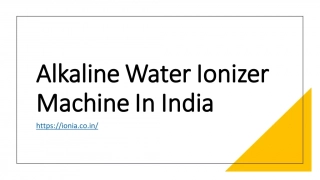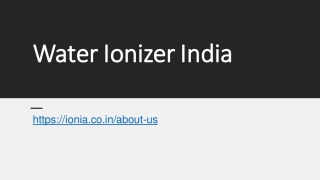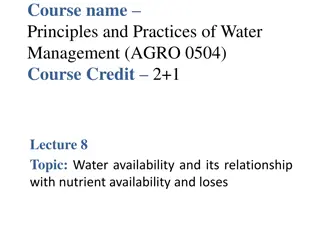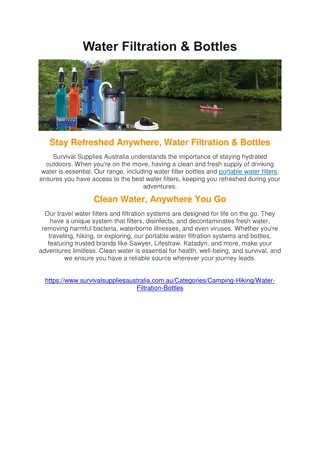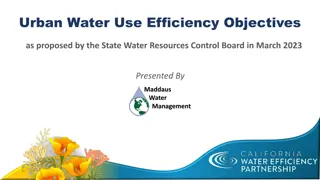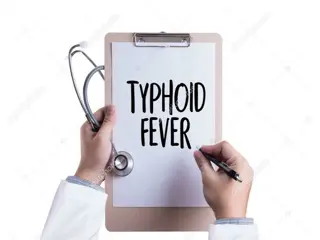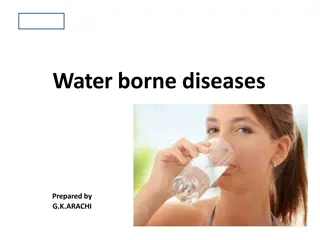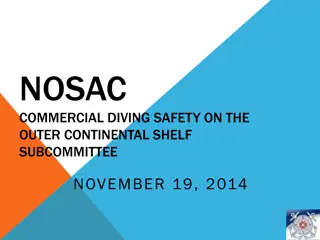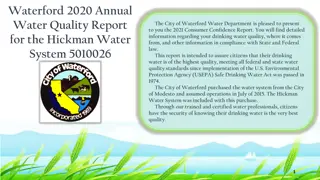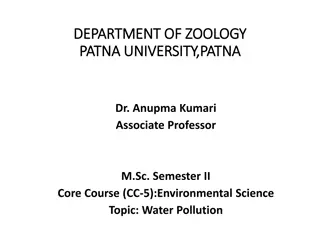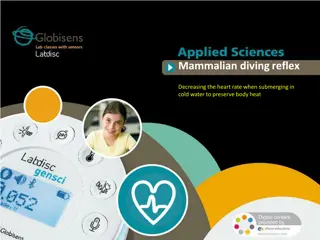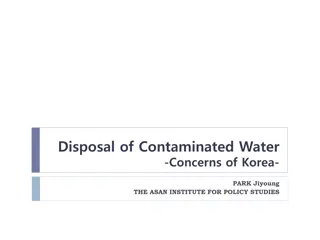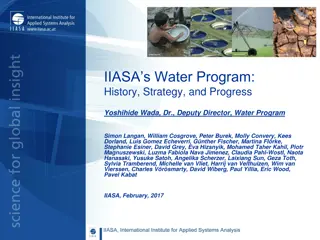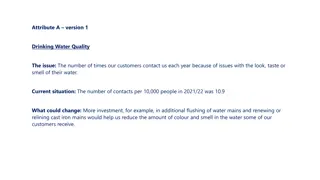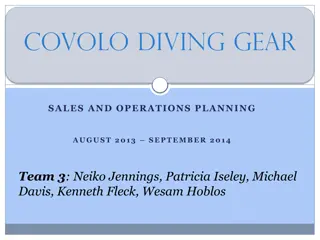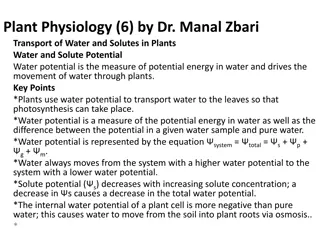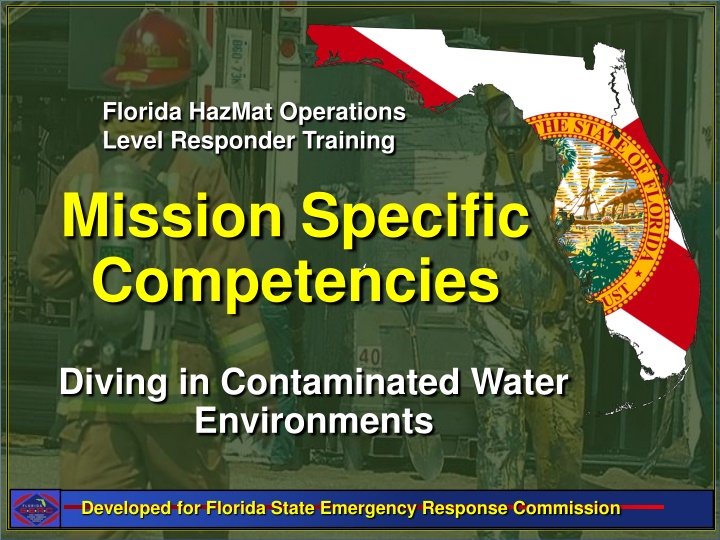
HazMat Operations Level Responder Training in Diving Contaminated Water Environments
Explore the specialized training required for HazMat Operations Level Responders in diving within contaminated water environments, including prerequisites, methods of instruction, and the risks associated with contaminated water rescue. Understand the purpose of the program, water contamination types, and biological contamination sources. Gain insights into pathogens and toxins in water, emphasizing safety protocols and competency development.
Uploaded on | 4 Views
Download Presentation

Please find below an Image/Link to download the presentation.
The content on the website is provided AS IS for your information and personal use only. It may not be sold, licensed, or shared on other websites without obtaining consent from the author. If you encounter any issues during the download, it is possible that the publisher has removed the file from their server.
You are allowed to download the files provided on this website for personal or commercial use, subject to the condition that they are used lawfully. All files are the property of their respective owners.
The content on the website is provided AS IS for your information and personal use only. It may not be sold, licensed, or shared on other websites without obtaining consent from the author.
E N D
Presentation Transcript
Florida HazMat Operations Level Responder Training Mission Specific Competencies = Diving in Contaminated Water Environments Developed for Florida State Emergency Response Commission
Prerequisites for Diving in Contaminated Water Environments Meet all competencies for: Awareness Level Operations Level Mission Specific Personal Protective Equipment Operations level responder assigned to Diving in Contaminated Water Environments Meet all competencies in this section =
Method of Instruction Classroom activity (lecture and exercise) Group PPE demonstration and practice =
Contaminated Water Rescue divers are not trained to enter extremely contaminated water. Most water in the US has some level of contamination. Rescue diving is a very specialized skill, can be dangerous, and requires continuous training. Adding a hazmat component makes this skill even more dangerous. =
Purpose of this Program Provide a basic overview of diving equipment and procedures for diving in contaminated water. If this is an expected skill the AHJ must have policies and procedures and provide training prior to expecting the procedure to be used. =
Water Contamination Water can contain: Biological Chemical Radiological Agents Three routes of exposure to a diver: Inhalation Ingestion Skin/eye absorption If the contamination is known, research to find the routes of entry and signs and symptoms of exposure should be known. =
Biological Contamination Created by: Humans Animals Industrial sewage Marine and fresh water organisms Shipping Hazardous waste sites Run-off Can be pathogens or toxins =
Pathogens and Toxins Concentrate in sediment on the bottom or float on top on surface material. Not often in the water column. Include: Viruses Bacteria Parasites Bacteria is the most common and found in every body of water. =
Eschericia Coli (E.coli) E.coli is found in many bodies of water. Created from sewage entering water. Normal bacteria in the bowel. Exposed to other parts of the body can cause infection. =
Other Biological Exposures Contact with potentially infected items like medical waste or hypodermic needles. Divers should have and be up to date with immunizations required for healthcare workers such as Hepatitis A&B and Tetanus. Divers should be trained in exposure control. NOTE: If the incident is a long operation or body recovery, fatigue, and mental health issues need to be addressed. =
Industrial Toxic/Chemicals Contamination can vary widely in solubility, toxicity, and permeability when spilled in water Primary source Industry Sewage Hazardous Waste Run-off If the product is known access reference materials (NIOSH Pocket Guide) to determine routes of entry and toxic levels. =
Hydrocarbons Probably the most common chemical contamination in the water. Include: Solvents, oils, fuels, and larger polyaromatic hydrocarbons (PAH). PAH is one of the heaviest hydrocarbons able to evaporate and dissolve in water. Some chemicals are cancer causing, cause burns or irritation of the skin and eyes, or cause sensitivity reactions. =
Radiological Contamination May respond to water contaminated with radiation. Occurs by accident or a terrorist attack. Typically not done by public safety divers. It is not uncommon in military divers and contract divers working for the Armed Forces. =
Equipment Provides both respiratory and physical protection. Mucous membranes are the most vulnerable regions to contamination. By isolating these areas, it is difficult for chemicals and biological agents to enter the body. =
SCUBA Includes a half-face mask and a mouthpiece regulator. Diver s mouth is in constant contact with water exposure. Contamination can enter through the exhaust valve and become aerosolized and enter the respiratory system. SCUBA is not a good choice and should be avoided for entering a significantly contaminated body of water. =
Full-Face Mask If only a biological contamination in the water, a full-face mask with a SCUBA tank may provide adequate protection. A full-face mask does not resolve the droplet inhalation concern and does not protect the head, neck, or ears which are high hazard sites. =
Surface Supplied Air Systems Combined with a full-face mask provide the highest level of respiratory protection. Typically operate on a positive pressure method, limiting the amount of water in the mask. Most have full communication allowing the diver to give updates and findings. =
Body Protection Wet suits provide little protection and may actually increase the exposure. These should not be considered in contaminated water. Dry suits are the only acceptable suits for contaminated water diving. When worn correctly there should be no water entering the suit. Doffing of dry suits decontamination procedures should be in place when exiting the contaminated environment and before doffing the suit. =
Diving in Contaminated Water Not a normal function for public safety divers. Must follow risk vs benefit prior to making a decision to enter contaminated water. Probably the only reason a rescue diver would enter contaminated water is to execute a rescue. A victim displaying signs of life may indicate that the contamination level is not high. Exception to this is biological pathogens and radiation that could be at lethal levels. =
In All Cases AHJ must have appropriate equipment available. AHJ must have SOPs in place. Responders must be trained. Appropriate number of responders to serve as back up, decontamination team, support, and recovery. =

